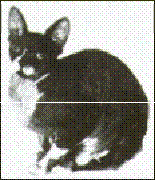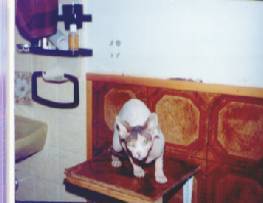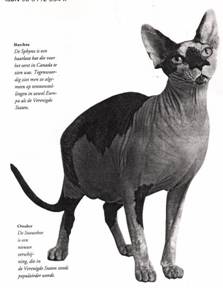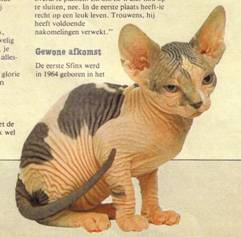THE SPHYNX
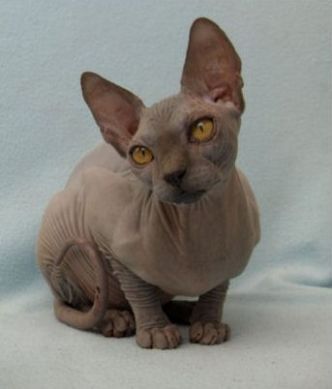
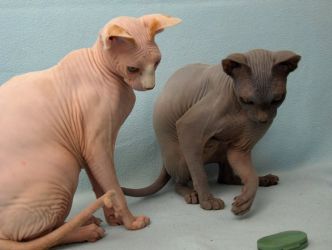
all the splendid subjects of the photos where not various specified are of the breeding ANCIENT TOWER
GENERAL: the most distinctive feature of this cat is its appearance of hairlessness. The Sphynx is of medium size and body conformation with surprising weight for its size. Females are generally smaller than males. The body feels warm and soft to the touch, with a skin texture akin to either a soft peach or a smooth nectarine. The Sphynx is sweet-tempered, lively, and amenable to handling.
SUGGESTED BREEDINGS by MENANDPETS.COM
No breeding to signal
if you want to know like signaling yours, contacts: marketing@inseparabile.it
HEAD: the head is a modified wedge, slightly longer than it is wide, with prominent cheekbones, a distinctive whisker break and whisker pads giving a squared appearance to the muzzle. The skull is slightly rounded with a flat plane in front of the ears. The nose is straight and there is a slight to moderate palpable stop at the bridge of the nose.
CHEEKS AND CHEEKBONES: prominent, rounded cheekbones which define the eye and form a curve above the whisker break.
MUZZLE AND CHIN: whisker break with prominent whisker pads. Strong, well developed chin forming perpendicular line with upper lip.
EARS: large to very large. Broad at the base, open and upright. When viewed from the front, the outer base of the ear should begin at the level of the eye, neither low set nor on top of the head. The interior of the ears is naturally without furnishing.
EYES: large, lemon-shaped, with wide-open center while coming to a definite point on each side. Placement should be at a slight upward angle, aligning with the outer base of the ear. Eyes to be wide set apart with the distance between the eyes being a minimum of one eye width. Eye color immaterial.
BODY: the body is medium length, hard and muscular with broad rounded chest and full round abdomen. The rump is well rounded and muscular. Back line rises just GO BACK TO LIST the shoulder blades to accommodate longer back legs when standing. Boning is medium.
NECK: the neck is medium in length, rounded, well muscled, with a slight arch. Allowance to be made for heavy musculature in adult males.
LEGS AND FEET: legs are medium in proportion to the body. They are sturdy and well muscled with rear legs being slightly longer than the front. Paws are oval with well-knuckled toes; five in front and four GO BACK TO LIST. The paw pads are thick, giving the appearance of walking on cushions.
TAIL: slender, flexible, and long while maintaining proportion to body length. Whip-like, tapering to a fine point.
COAT/SKIN: the appearance of this cat is one of hairlessness. Short, fine hair may be present on the feet, outer edges of the ears, the tail, and the scrotum. The bridge of the nose should be normally coated. The remainder of the body can range from completely hairless to a covering of soft peach-like fuzz whose length does not interfere with the appearance of hairlessness. This coat/skin texture creates a feeling of resistance when stroking the cat. Wrinkled skin is desirable, particularly around the muzzle, between the ears, and around the shoulders. There are usually no whiskers but if whiskers are present they are short and sparse.
COLOR: color and pattern are difficult to distinguish and should not affect the judging of the cat. White lockets, buttons, or belly spots are allowed.
PENALIZE: hair other than described. Delicate or frail appearance. Thin abdomen, thin rump, or narrow chest. Bowed front legs. Should not resemble the Devon Rex, Cornish Rex or Oriental body type.
DISQUALIFY: kinked or abnormal tail. Structural abnormalities. Aggressive behavior endangering the judge.
SPHYNX COLORS
GENERAL: all colors and patterns, in any combination, found in felines is acceptable.
WHITE: white to pink. Nose leather and paw pads: pink.
BLACK: black. One level tone from nose to tip of tail. Nose leather: black. Paw pads: black or brown.
BLUE: blue. One level tone from nose to tip of tail. Nose leather and paw pads: blue.
RED: deep, rich, clear, brilliant red, without markings. Lips and chin the same color as the skin. Nose leather and paw pads: brick red.
CREAM: one level shade of buff cream, without markings. Nose leather and paw pads: pink.
CHOCOLATE: rich chestnut brown, even throughout. Nose leather: brown. Paw pads: brown or cinnamon.
LAVENDER: frosty-grey with a pinkish tone, even throughout. Nose leather and paw pads: lavender-pink.
CINNAMON: cinnamon, even throughout. Nose leather and paw pads: cinnamon.
FAWN: pale, pinkish fawn, even throughout. Nose leather and paw pads: pale fawn.
CLASSIC TABBY PATTERN: markings clearly defined on legs and tail. Pattern tends to fade on hairless body. Legs evenly barred with bracelets coming up to meet the body markings. Tail evenly ringed. Several unbroken necklaces on neck and upper chest, the more the better. Markings seen on the skin. Frown lines on head form an intricate letter "M" Unbroken line runs back from outer corner of eye. Swirls on cheeks. Vertical lines over back of head extend to shoulder markings which are in the shape of a butterfly with both upper and lower wings distinctly outlined and marked with dots inside outline. Back markings consist of a vertical line down the spine from butterfly to tail with a vertical stripe paralleling it on each side, the three stripes well separated by stripes of the ground color. Large solid blotch on each side to be encircled by one or more unbroken rings. Side markings should be the same on both sides. Double vertical rows of buttons on chest and stomach.
MACKEREL TABBY PATTERN: markings clearly defined on legs and tail. Pattern tends to fade on hairless body. Legs evenly barred with narrow bracelets coming up to meet the body markings. Tail barred. Necklaces on neck and chest distinct, like so many chains. Head barred with an "M" on the forehead. Unbroken lines running back from the eyes. Lines running down the head to meet the shoulders. Spine lines run together to form a narrow saddle. Narrow pencillings run around body.
SPOTTED TABBY PATTERN: markings on the body to be spotted. The spots can be round, oblong, or rosette-shaped. Any of these are of equal merit but the spots, however shaped or placed, shall be distinct. Spots should not run together in a broken Mackerel pattern. A dorsal stripe runs the length of the body to the tip of the tail. The stripe is ideally composed of spots. The markings on the face and forehead shall be typically tabby markings. Underside of the body to have "vest buttons." Legs and tail are barred. Markings clearly defined on legs and tail. Pattern tends to fade on hairless body.
PATCHED TABBY PATTERN: a patched tabby (torbie) is an established silver, brown, blue, lavender, fawn, cinnamon or chocolate tabby with patches of red or cream clearly defined on both the body and extremities; a blaze on the face is desirable.
SILVER TABBY: skin ground color, including lips and chin, pale clear silver. Markings dense black. Nose leather: brick red. Paw pads: black.
BROWN TABBY: skin ground color brilliant coppery brown. Markings dense black. Lips and chin the same shade as the rings around the eyes. Back of leg black from paw to heel. Nose leather: brick red. Paw pads: black or brown.
BLUE TABBY: skin ground color, including lips and chin, pale bluish ivory. Markings a very deep blue affording a good contrast with skin ground color. Nose leather: old rose. Paw pads: rose.
RED TABBY: skin ground color red. Markings deep, rich red. Lips and chin red. Nose leather and paw pads: brick red.
CREAM TABBY: skin ground color, including lips and chin, very pale cream. Markings buff or cream sufficiently darker than the ground color to afford good contrast but remaining within the dilute color range. Nose leather and paw pads: pink.
CHOCOLATE (Chestnut) TABBY: skin ground color is warm fawn, markings are rich chestnut brown. Nose leather: chestnut, or pink rimmed with chestnut. Paw pads: cinnamon.
CHOCOLATE-SILVER TABBY: skin ground color, including lips and chin, is silver. Markings rich chestnut. Nose leather: chestnut or pink rimmed with chestnut. Paw pads: cinnamon.
CINNAMON TABBY: skin ground color, including lips and chin, a pale, warm honey, markings a dense cinnamon, affording a good contrast with skin ground color. Nose leather: cinnamon or coral rimmed with cinnamon. Paw pads: cinnamon.
CINNAMON-SILVER TABBY: skin ground color, including lips and chin, a pale glistening silver. Markings dense cinnamon. Nose leather: cinnamon. Paw pads: coral.
LAVENDER TABBY: skin ground color is pale lavender. Markings are a rich lavender, affording a good contrast with skin ground color. Nose leather: lavender, or pink rimmed with lavender. Paw pads: lavender-pink.
LAVENDER-SILVER TABBY: skin ground color, including lips and chin, a cold clear silver. Markings lavender. Nose leather: lavender or pink rimmed with lavender. Paw pads: lavender-pink.
FAWN TABBY: skin ground color, including lips and chin, pale ivory, markings dense fawn, affording good contrast with skin ground color. Nose leather and paw pads: pale fawn.
TORTOISESHELL: black mottled or patched with red and/or cream. Blaze on face desirable.
BLUE-CREAM: blue mottled or patched with cream. Blaze on face desirable.
CHOCOLATE (Chestnut) TORTOISESHELL: rich chestnut brown mottled or patched with red and/or cream. Blaze on face desirable.
CINNAMON TORTOISESHELL: cinnamon mottled or patched with red and/or cream. Blaze on face desirable.
LAVENDER-CREAM: lavender mottled or patched with cream. Blaze on face desirable.
FAWN-CREAM: fawn mottled or patched with cream. Blaze on face desirable.
CALICO: white with unbrindled patches of black and red. White predominant on underparts.
VAN CALICO: white with unbrindled patches of black and red confined to the extremities; head, tail, legs. One or two small patches of color on body allowable.
DILUTE CALICO: white with unbrindled patches of blue and cream. White predominant on underparts.
DILUTE VAN CALICO: white with unbrindled patches of blue and cream confined to the extremities; head, tail, legs. One or two small patches of color on body allowable.
BI-COLOR: solid color and white, tabby and white, tortoiseshell and white, pointed and white, any color and white, etc.
VAN BI-COLOR: solid color and white, tabby and white, tortoiseshell and white, etc., with color confined to the extremities; head, tail, and legs. One or two small patches on body allowable.
FAWN CALICO, LAVENDER CALICO, CINNAMON CALICO, CHOCOLATE CALICO: as for calico above, with appropriate marking color.
FAWN VAN CALICO, LAVENDER VAN CALICO, CINNAMON VAN CALICO, CHOCOLATE VAN CALICO: as for van calico labove, with appropriate marking color.
POINTED PATTERN: point restricted colors show little or no color contrast between body and points in the mature Sphynx. Although born very light in color, the pointed Sphynx will darken and appear solid in color as an adult. Eye color: vivid blue. Nose leather and paw pads: appropriate to coat color. The pointed pattern may be combined with ANY other pattern (except mink) and ANY colors, e.g. lilac-silver lynx point and seal-tortie point with white (shown in the Bi-Color Class).
MINK PATTERN: point restricted colors show little or no color differentiation between body and points in the mature Sphynx. Although born very light in color, the mink Sphynx will darken and appear solid in color as an adult. Eye color: aqua. Nose leather and paw pads: appropriate to coat color. The mink pattern may be combined with ANY other pattern (except pointed) and ANY colors, e.g. natural mink, blue mink, champagne mink, platinum mink, natural tabby mink, blue-cream, tortie mink and white (shown in Bi-Color Class).
SABLE: the mature specimen is a rich, warm, sable brown without shadings, barring, or markings of any kind. (Kittens are often lighter in color.) Nose leather and paw pads: brown.
CHAMPAGNE: the mature specimen should be a warm honey beige without shadings, barring, or markings of any kind. Nose leather: light, warm brown. Paw pads: warm, pinkish tan.
PLATINUM: the mature specimen should be a pale, silvery gray without shadings, barring or markings of any kind. Nose leather and paw pads: lavender-pink.
OSC (Other Sphynx Colors): any other color or pattern. Cats with no more than a locket and/or button do not qualify for this class, such cats shall be judged in the color class of their basic color with no penalty for such locket and/or button. Examples: any color with one, two, three, or four white feet. All point restricted colors such as seal point, chocolate point, natural mink, blue mink, sable, champagne, platinum, etc.
above the CFA Breed Standards
after automatic translate from inseparabile.com
WHO THE SPHYNX:
Sphynx the not exactly stereotype of cat, but a cat allennesima power! Every characteristic of the Feline from house in this amplified race, in order to create cos a animaletto that of sure rendering little borings the days of its future humans. The word landladies with the sphynx to forget, you will be ITS human! Like far away the DevonRex cousins, the sphynx it has a character MUCH cake and A LOT giocherellone, its days pass inexorable between run crowds and know to you, and longest slept appisolati in the strange and impossible devout positions that you have never been able to see.
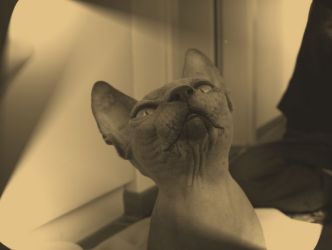
To decide makes to adopt from a sphynx means you to want to change your vision of the life, every thing sar absolutely turned towards of he, not sar of sure one presence of frame in your day, but INDEED, every your single gesture acquister various meaning; sar for you impossible to sleep peacefully and solitary poich you will have always a renter invading in the bed, than you bacer and to make noisiest fused; sar impossible to cook without to have it, in the best one of the hypotheses, coiled miagolante to your legs; sar impossible to write something to the computer without having to fight with a typist crowds that add to incomprensibili letter sequences to written yours; sar impossible to watch the television set appisolati on the divano without to have it on your arms that struscia on the face, waves to avoid that you can also only think to consider the devout TV of he. These are only some small examples in order to make to understand like the sphynx are not a cat that can carry company in a house, sphynx a cat that the house monopolizes it, clown born and with a its gesta and its affection not to render boring also a single minute of your permanence in apartment. For this sphynx a cat that has continuous need of company, not the gattino that pu to only let for many hours the day, in how much trover sure the way for distrarsi and altres the way in order to obligate to you, once returns to you to house, interminable sitting of coccole in order to repair allaffronto to have it, to its way to see, abandoned for cos much time! Every cucciolo then it has clearly a its various character, in how much living being, but us that sure that to have this type of cat he means to have in house a continuous surprise and ABSOLUTELY not to feel never single, and it seems strange to dirsi, incompresi, in how much you will notice like this relationship much active one you carry sphynx and the its human to be understood to the first look, to living nearly in simbiosi! Nudit therefore the not sure its detached characteristic devout, its gift that one to render every day with he an enormous and wonderful adventure!
HISTORY:
Since it knots were devout ancient puppys totally are appeared like spontaneous mutation in cucciolate of normal cats in several parts of the world.
In 1902, a brace of the New Mexico (the Albuquerque getlteman), received from some Indians of pueblo local two cats knots, Nellie and Dick, than it is told were the last ones remained of an ancient race raised from the Aztecs; the two cats were not couple to you and they did not give cos to life to one descendancys.
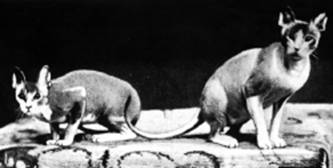
NELLIE and DICK
With continuing of the years other cases of spontaneous mutations came to acquaintance of public opinion (1936 in Carolina of the North, 1938 and 1950 in France) until 30 January of 1966 when in Ontario (Canada) one gatta white woman and black from the normal fur, Elizabeth, female gave to the light one totally black white woman and knot, call later on Prune. The breeders Rydiadh and Yania Bawa and Keese and Rita Tenhove recovered the micina and decided to call this new race Moonstone Cats, Canadian Hairless, Chat Sans Poil and then finally Sphynx.
In 1975 a soriana gattina Brown tabby, Jazabelle, that it lived in the small farm of the Pearson in the Minnesota, gave to the light one then puppysna called knot Epidermis. In the 1976 Jazabelle partor newly, to the inside of the cucciolata one new gattina was one knot, Dermis. The Pearson will sell the gattine to the Z breeding. Stardust di Kim Mueske.
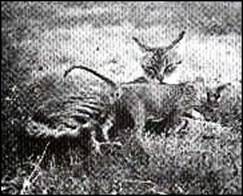
JAZABELLE and EPIDERMIS
Kim I couple varied times the micine, that they always give birth gattini hairy; finch, under the council of the Dr.. Pfluger, mrs. Mueske I do not couple one of the gattini been born with the mother, obtaining cos three gattini knots. The important connection devout avverr later on between Cantaur' s Hercules of Z.Stardust (a Devon red Rex) and Epidermis from which being born Z. Stardust' s Winnie Rinkle of Rinkurl, one gatta fondatrice of the race, that we find in the majority of the pedigree of the existing cats sphynx today. Dermis to die in 1989 to ET of 13 years, Epidermis catching up in 1991 to 16 years of ET, and its Winnie daughter in March of 2002 to spread ET of the mother.
In the June of 1978 to Toronto (Canada) Shirley Smith, a breeder of Siamesi, it was called in order to recover two cats abandons to you been born from a gattina randagia, one of these micini was a cat R-bianco.e.nero knot that was called Fools. Fools were in a sorry state, and its genitals them were malamente compromises and cripples, had cos to be sterilized. Fools termin its life with Linda Birks of the Aztec breeding where mor to veneranda ET of 19 years.
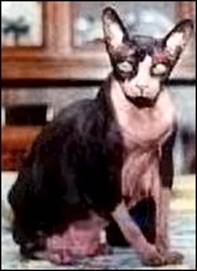
FOOLS
The mother of Fools gave in the light of gattini the knots newly; in 1979 and 1980, from two cucciolate various ones, nacquero Paloma and Punkie. These two gattine came sent in Holland from the Dr.. Hugo Hernandez who was trying to select this new race. Punkie came coupled with a male white man of race Devon Rex, To cure Van Jetrophin, and gave to the light five puppys.
|
|
|
|
PALOMA |
PUNKIE |
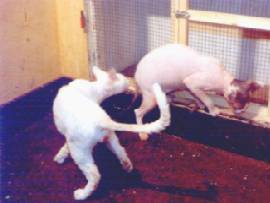
PUNKIE and TO CURE Van Jetrophin
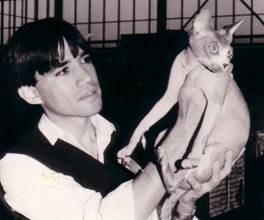
Dr. Hugo Hernandez with one of the puppys, Q Ra.
One of these puppys, Q Ra, and to living with a Danish breeder, Tonia Vink. Paloma was coupled with Ramses (brother of Q Ra) and nacque cos an other bench mark of the race, Hator de Calecat dictates Tulip. In the 1983 this same connection to be born one cucciolata of five puppys, one of these sar the important Chnoem de Calecat.
|
|
|
|
HATOR de CALECAT |
TULIP H. de Calecat Cucciola |
In the 1985 Walt and Carol Richards, of the Britanya breeding in Texas, they begin a program of breeding intercrossing Devon Rex (of which they are breeders) and sphynx. From one they Devon, Britanya' s Aida Lott, coupled with Chnoem de Calecat (ET), nacquero four puppys that will make the history of the race appearing like ancestors in very many pedigree. The puppys, Britanya' s Lady Godiva, Britanya' s Lord and I' m Naked, Britanya' s Baroness Quizzit, and Britanya' s Gremlin of Petmark, was exposed to Anaheim (California) where Godiva was the first Sphynx to obtain the Supreme title it of Grand Champion TICA.
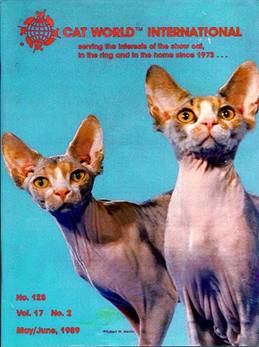
LADY GODIVA and BARONESS QUIZZIT
From then new puppys knots of natural mutations they are NATO, and many are used in order to increase the pool genetic of the race. Many steps are made in order to avoid inbreeding tight that door to the insorgence of genetic diseases and still today in course a program of hybridization with the domestic cat (from whose mutation exactly is born the Sphynx) in order to try to avoid what the heel of achille of the race, the HCM (ipertrofica Cardiomyopathy), arriving to of amazingly turns out to you good.
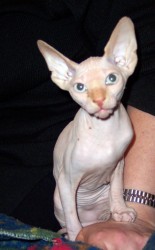
The photo of this beautifulst one sphynx there be sended gives tila79
Cures:
With the exception of us that pu to appear, the Sphynx a healthy cat much and sturdy one, but as every gattino of race it has its heel of Achille that in this case represented from its well-known one nudit. This does not mean absolutely that it must be held in a glass bell, but like just all human we, it feels the cold; a cold place for we also for he! A place a place adapted to a Sphynx where also we (knots) could be felt well. Here perch a cat exclusively of covered apartment where pu to find to the occurrence, cucce, divani and quant' other it can be useful for russare to the homely tepore warmth.
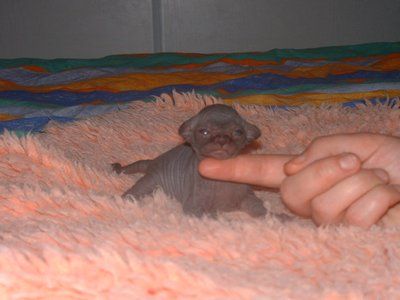
The skin the sphynx reacts just as one normal skin and for this has need of protect from the solar beams with a cream to screen total, waves evitargli painful summery scottature, while the first sun spaparanzato to zanzariere of our windows is enjoyed close. _ a an other characteristic of this cat that one to sudare, or still better say that the its oil corporeo not have hair that it withhold and here therefore that a bagnetto every 2 week approximately serve in order remove the grease to the its body and make it return perfect candid; like human we of the rest, every single cat avr devout or less this propensione to the oleosa secretion, sar therefore our cure to wash it every which time the reputiamo necessary; There to add for that the drying then not us porter via much time; -).
With its enormous large ear peelings, the race then characterized from an abundant cerumen production, than it is kept calmly sottocontrollo with pulizie weeklies magazine of the auricular pavilion with normal rods for the orecchie; important in order to only clean up the visible zone, and never to penetrate themselves in the auditory channel, waves to avoid to provoke undesired damages.
Like every gattino of race, the Sphynx above all has need of balanced food and of HIGH qualit, only the doses will be leggermente advanced to those of the others gattini, inasmuch as the calories to our friend knot serve also to maintain to an active metabolism for one enough high corporea temperature; You do not take care yourselves for the danger of weight increase, the Sphynx it knows sure like smaltire the ingested fat person, exhibiting itself giornalmente in race, knows to you and quant' other can render it a clown born.
The Sphynx a extremely needy cat of company, important therefore that a person can pass with he several hours, otherwise the choice devout frequently continuation that one of trovargli a feline companion (not necessarily of the same race, and not even necessarily of race) that can compensate its need of game, affection and company during the hours in which the its human outside house for job. If you are not disposed to this, then better if opted for an other race.

STANDARD:
|
GENERAL |
|
Ransom: average, extraordinarily heavy. |
|
head |
|
Shape: a wedge modified with contours rounds off to you, devout leggermente long that wide |
|
Skull: leggermente rounded off with one rather flat surface. |
|
Profile: stop from light to moderated, the base of the straight nose. |
|
Zigomi: prominenti. |
|
Muso/Mento: strong snout, rounded off; mento solid. |
|
Moustaches: it breaks to you, rather thick. Or absent. |
|
Orecchie |
|
Shape: large, wide to the base and opened, leggermente rounded off to the estremit. The inner pavilion completely lacking in hairs. One modest quantit of thin hairs allowed on the external edge, to the base of the ear. |
|
Placing: straight, n low n high on the head; they form a light angle. |
|
Eyes |
|
Shape: to lemon shape, large, placed in oblique towards the external edge of the ear. The distance between the eyes greater of the dimension of the same eye. |
|
Color: the ideal conforms to the ink of the cape. |
|
Neck |
|
Of medium length, bombato and muscoloso. Arch from the shoulders to the base of the skull. Sturdy, especially in the males. |
|
Body |
|
Structure: medium along, hard and muscoloso, not gracile. Bombato but not obese Ventre. Chest very developed. |
|
Legs |
|
Long, proporzionate to the body. Those posterior devout leggermente long ones of the front ones. Front legs very spread. Medium, solid skeleton; muscles very develop to you. |
|
Feet: ovals with prominenti, long and thin fingers. Of medium ransom. The plantari, devout bearings thick that in the others breeds, the impression gives that the cat you walk on "air cushions" |
|
Tail |
|
Thin, thick to the base affina towards the estremit. Length proporzionata to the body. The "tail from lion" (with a ciuffetto of hairs to the estremit) accepted. |
|
HAIR And SKIN |
|
It seems not to have hairs, but it could be covered from and a short thin one sottopelo. Forelocks us hair to the estremit of the tail are allowed. |
|
Webbing: scamosciata to the touch; pu to be perceived a resistance feeling when the skin some subject is caress. |
|
Wrinkles: wished one rugosa skin, above all around the snout, between the orecchie and around the shoulders. However, the wrinkles do not have to prevent the normal functions of the cat. |
|
Color: all the colors are accepted, included the capes with white man. All the quantit of white man are allowed. |
|
OBSERVATIONS |
|
The cat does not have to be of small or gracile ransom. The males can amazingly be large and long on condition that the proportions are maintained. |
|
DEFECTS |
|
Head: straight profile, head tightened, lack of wrinkles on the head. |
|
Body: small, gracile, too much esile or lacking muscular tone. And short compact or of type "it orients them". |
|
Hair: presence of hair to outside of the zones previously described. The presence of waved hair that memories that one of the Devon or the Cornish rex in dumb, not accepted. Evidences of rasatura. |
|
Scale of the points |
|||||||||||||||||||||||||||||||||||||||||||||||||
|
Total 100 |
|||||||||||||||||||||||||||||||||||||||||||||||||
|
FEEDING
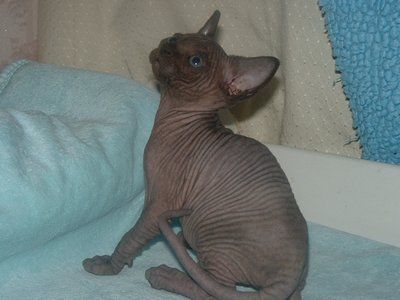
For the devout feeding it goes calculated a leggermente abundant dose regarding a cat with the hair, perch consume many devout calories in order to maintain to constant their corporea temperature.
Curiosit
Many persons who suffer from allergies to the cats can tolerate the life with the cats of Sphynx. However, according to the type and the severit of the allergic reactions of the individual, for some and adviced against also this cat.
A question that often comes mail to the breeders
"This cat does not have cold" If one cold room for you also for a cat the knot but sure this intelligent cat trover sure a human being or a warm animal on which appisolarsi.
The Sphynx the much rare and greater part of the selezionatori have a long attended list of for theirs gattini that they only come delivered to the new owners after the 12 weeks of ET.
